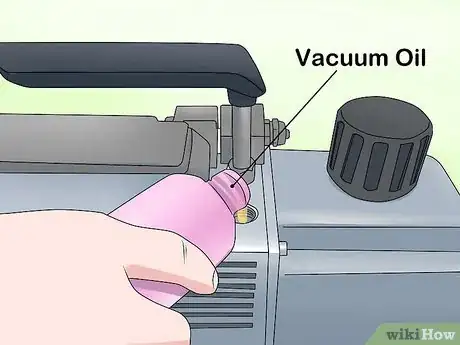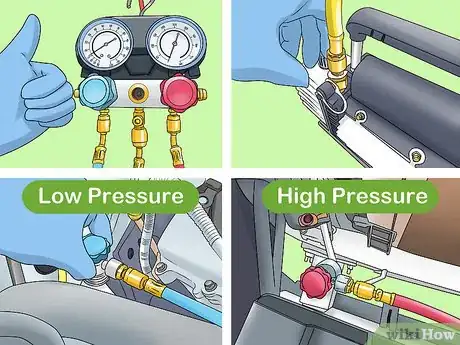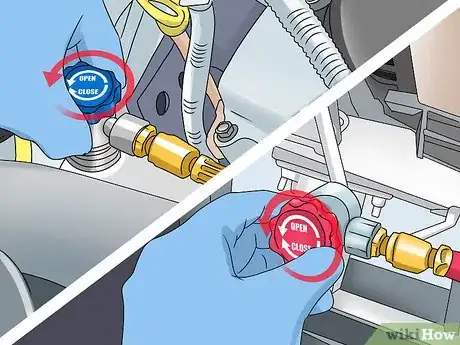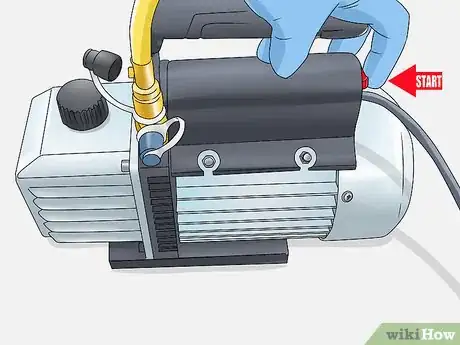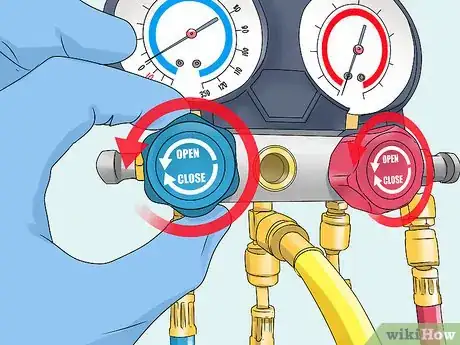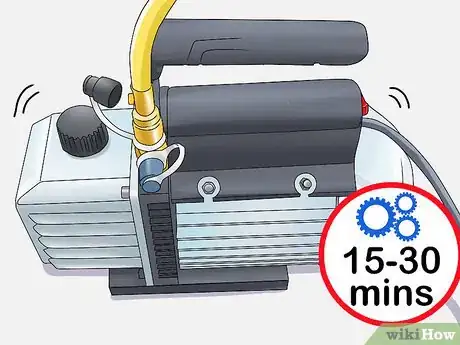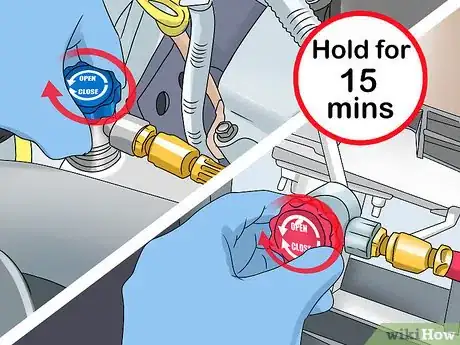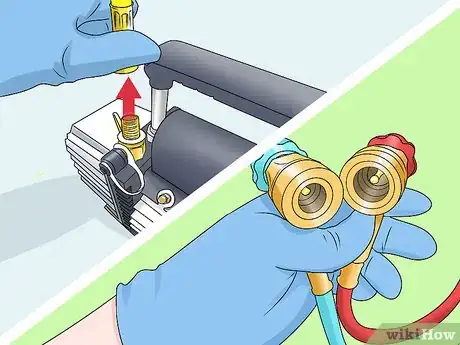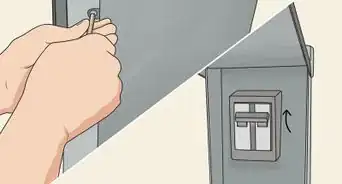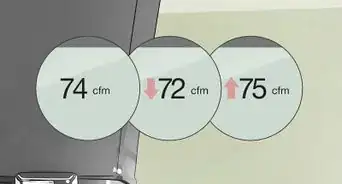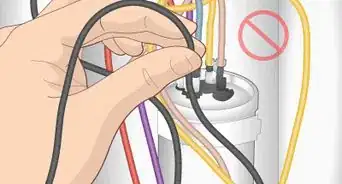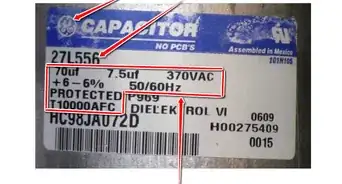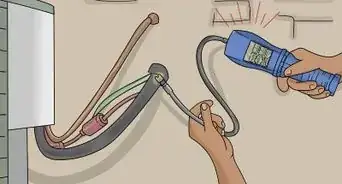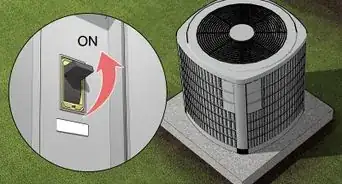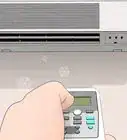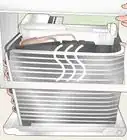This article was co-authored by Victor Belavus. Victor Belavus is an Air Conditioning Specialist and the Owner of 212 HVAC, an air condition repair and installation company based in Brooklyn, New York. In addition to HVAC and air conditioning units, Victor also specializes in furnace repair and air duct cleaning. He has over 10 years of experience working with HVAC systems.
There are 7 references cited in this article, which can be found at the bottom of the page.
This article has been viewed 239,014 times.
Pulling a vacuum is a common part of air conditioning repairs. Vacuums are used to evacuate ACs, a process by which they pull out all air and moisture from the refrigerant system prior to testing, repairs, and recharging. Generally, this is best done by an HVAC professional. If you are looking to do simple at-home repairs, though, learning to use a vacuum pump could be very helpful.
Steps
Setting up Your Vacuum Pump
-
1Fill the pump with vacuum oil. Before you use your vacuum pump, make sure it is full of clean vacuum pump oil. Unscrew the oil fill cap, typically located on the top of the pump, and look on the interior edge of the opening for the fill line. Fill the opening with oil until it reaches that line. Then, replace the oil fill cap.[1]
- Be sure to only use oil meant for vacuum pumps. Using other mechanical oils could impact the quality and performance of your vacuum.
-
2Attach your gauges to the ports. You will need a gauge set that connects to both your vacuum and your pressure ports on your AC system. The blue gauge and hose should connect to the low-pressure service port. The red gauge and hose will connect to the high-pressure port. The yellow hose in the middle should connect your gauges to your vacuum.[2]
- Make sure the gauges and gauge hoses are connected tightly. Loose seals can compromise your vacuum.
- In your car, your high-pressure port will generally be physically higher than the low-pressure port.[3]
Advertisement -
3Open your manifold valves. Once you have your gauges in place, you will need to use the valves on your AC system that opens and closes the service port to the refrigerant lines. With the valves closed, your gauges should have little to no pressure reading.[4]
Pulling the Vacuum
-
1Start your pump. After you are sure everything has been securely connected, use the switch device on your vacuum pump to turn it on. You should be able to hear the vacuum running once it is switched on.[5]
- If you are trying to start the pump in cold weather, open the intake ports until the pump reaches normal running speed. Then, close it off again.[6]
-
2Open the side gauge valve. Once your vacuum is on, you will need to open the gauge valves, located on the side of each gauge. This allows the vacuum to start pulling air out of the system.[7]
- If you are unsure which way you need to turn your valves to open them, check the manual that came with your gauges or vacuum.
-
3Allow the vacuum to run for 15-30 minutes. Let your vacuum run at full operating speed for at least 15 minutes and up to 30 to completely pull the air out of your AC system. The exact amount of time you will need to let your vacuum run will vary based on your manufacturer’s recommendations, so check any operational manuals you may have for both your AC system and vacuum pump.[8]
- Generally, you want to let your vacuum run for at least long enough to get the measurement below 1,000 microns. If you can, try to get it down to 500 microns.
Closing Your Vacuum
-
1Close the low-side valve and let the vacuum hold for 15 minutes. After you have let your vacuum run for a sufficient amount of time, close the valve that connects to the low-side gauge. Let your pump hold the vacuum for 15 minutes.[9]
- If it’s not able to hold for that long, you likely have a leak and may need to replace components on your vacuum pump.
-
2Shut off the vacuum pump. When you are satisfied with how long your system held the vacuum, shut the pump off using the same switch mechanism you used to turn it on. Let your vacuum disengage completely before you disconnect the system.[10]
-
3Disconnect your vacuum. Once your vacuum has fully disengaged, you can disconnect the hose leading to the pump. Your AC system should be fully evacuated at this point, and ready to be recharged or repaired.[11]
- If you have a drain issue, one of the most common problems in air conditioning, you can get a Co2 drain gun and an AC drain brush to clean the clog in the drainage system. It is better than using chemicals.[12]
- You should also replace filters regularly. It will help prevent clogs and debris collection on the bottom of the condensate drain pan.
- You can even get condensate pan tablets to prevent drain clogs.[13]
Things You'll Need
- Vacuum pump
- Low-pressure gauge
- High-pressure gauge
- Connecting hoses
References
- ↑ http://yellowjacketuniversity.com/articles/the-evacuation-and-charge-process/
- ↑ https://www.carid.com/articles/how-to-use-an-air-conditioning-manifold-gauge-set.html
- ↑ https://www.2carpros.com/articles/re-charge-an-air-conditioner-system
- ↑ https://www.2carpros.com/articles/re-charge-an-air-conditioner-system
- ↑ https://www.2carpros.com/articles/re-charge-an-air-conditioner-system
- ↑ http://yellowjacketuniversity.com/articles/the-evacuation-and-charge-process/
- ↑ https://www.2carpros.com/articles/re-charge-an-air-conditioner-system
- ↑ http://www.denlorstools.com/autoblog/2012/05/car-ac-vacuum-pumps-faqs/
- ↑ https://www.2carpros.com/articles/re-charge-an-air-conditioner-system
About This Article
To use a vacuum pump on an air conditioner, first, turn the pump on and open the side gauge valve, which will allow the vacuum to start pulling air out of your system. Once the valve is open, let your vacuum run at full speed for 15 to 30 minutes to pull out as much air as it can. The exact amount of time you need to let the pump run will depend on the manufacturer, so check the operational manual for a specific time. After the vacuum has run long enough, close the valve that connects to the low-side gauge and let your pump hold the vacuum for 15 minutes. Then, shut off the pump and disconnect the hose leading into it. For more tips, including how to know if your pump has a leak, read on.
